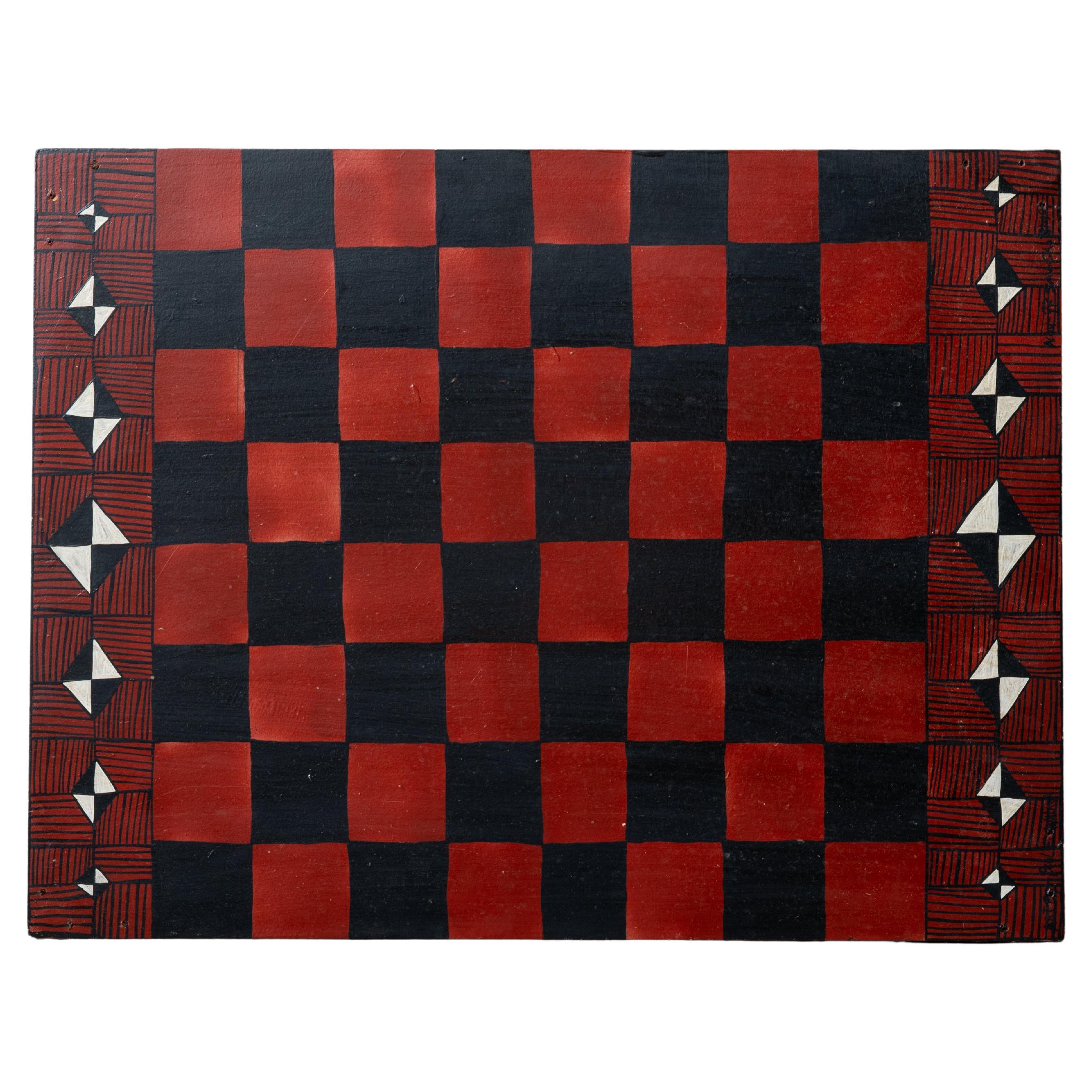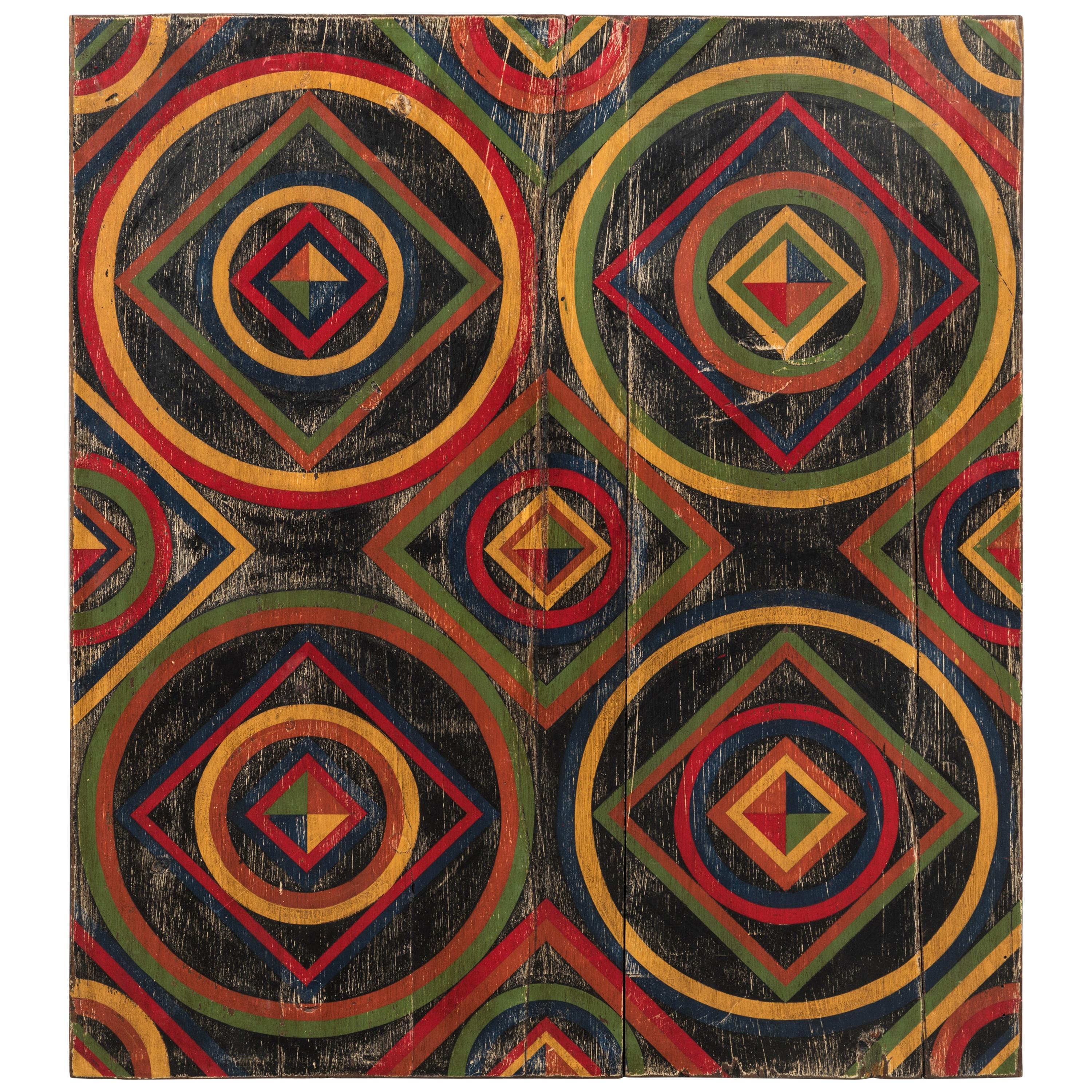Items Similar to Artisan abstract nail art, Netherlands 1950s
Want more images or videos?
Request additional images or videos from the seller
1 of 10
Artisan abstract nail art, Netherlands 1950s
About the Item
Abstract artisan folk art wall hanging. It is made of wood with nails hammered into it in a rectangular grid. The nails are hammered in at different depths and different in color creating a 3 dimensional image with a heart and arrow in the center. Over 10.000 nails were used in the creation of this piece and one can only imagine the time and effort it took to make it. Unfortunately the artist is unknown.
The piece has a fair amount of patina. The nails have some light rust.
- Dimensions:Height: 13 in (33 cm)Width: 39.38 in (100 cm)Depth: 2.37 in (6 cm)
- Style:Folk Art (In the Style Of)
- Materials and Techniques:
- Place of Origin:Netherlands
- Period:
- Date of Manufacture:1950-1960
- Condition:Wear consistent with age and use.
- Seller Location:ECHT, NL
- Reference Number:1stDibs: LU9426237460352
About the Seller
New to 1stDibs
Joined in the past six months.
5.0
Gold Seller
These expertly vetted sellers are highly rated and consistently exceed customer expectations.
1stDibs seller since 2023
5 sales on 1stDibs
Typical response time: 6 hours
- ShippingRetrieving quote...Ships From: ECHT, Netherlands
- Return PolicyA return for this item may be initiated within 14 days of delivery.
More From This SellerView All
- Mid century copper wall mirror, Netherlands 1950sLocated in ECHT, NLMinimal design wall mirror. It has a round mirror in a copper frame. Handcrafted in the 1950s in the Netherlands. The copper has gained a beautiful patina throughout the years. The p...Category
Mid-20th Century Dutch Mid-Century Modern Wall Mirrors
MaterialsCopper
- Set of 2 wood and brass torcheres, Netherlands 1950sLocated in ECHT, NLSet of 2 floor standing candle holders. Made from wood and brass. They came from a monastery in Oirschot Netherlands The bases are made ...Category
Mid-20th Century Dutch Medieval Torchères
MaterialsBrass
- Set of 2 medieval style architectural sculpted columns, Netherlands 1950sLocated in ECHT, NLSet of two sculpted architectural columns. They are made from some kind of cast stone or plaster. They were probably meant as fireplace columns seeing the height of 104cm. They have ...Category
Mid-20th Century Dutch Medieval Architectural Elements
MaterialsPlaster
- Set of two hand carved brutalist stools, Netherlands 1950sLocated in ECHT, NLHandmade set of two brutalist stools. Hand carved from solid wood. The seats have serrated edges resembling industrial cogs. They differ slightly in size accentuating the handmade ch...Category
Mid-20th Century Dutch Brutalist Stools
MaterialsWood
- Modernist living room set in the manner of Gerrit Rietveld, Netherlands 1950sBy Metz & Co., De Stijl, Gerrit Rietveld, Walter GropiusLocated in ECHT, NLHandcrafted living room or patio set. It is made in the style of Gerrit Rietveld and is clearly inspired by his legendary "kratstoel" or "crate chair" where difference lies in the amount of slats in the seat and back. This set was made during the 1950s and is entirely made from pine and assembled using round headed screws that are recessed in the wood. Made with great eye for detail. The set consists of 2 two-seater sofas and 1 lounge chair. Dimensions sofa: W. 130cm H. 70cm D. 75cm Dimensions chair. W. 75cm H. 70cm D. 75cm Seat height: sloping back from 33 to 27cm Armrest height: 52cm De Stijl (Dutch for "The Style"), also known as Neoplasticism, was a Dutch art movement founded in 1917 in Leiden. De Stijl consisted of artists and architects. In a more narrow sense, the term De Stijl is used to refer to a body of work from 1917 to 1931 founded in the Netherlands. Proponents of De Stijl advocated pure abstraction and universality by a reduction to the essentials of form and colour; they simplified visual compositions to vertical and horizontal, using only black, white and primary colors. De Stijl is also the name of a journal that was published by the Dutch painter, designer, writer, and critic Theo van Doesburg that served to propagate the group's theories. Along with van Doesburg, the group's principal members were the painters Piet Mondrian, Vilmos Huszár, Bart van der Leck, and the architects Gerrit Rietveld, Robert van 't Hoff, and J. J. P. Oud. The artistic philosophy that formed a basis for the group's work is known as Neoplasticism—the new plastic art (or Nieuwe Beelding in Dutch). According to Theo van Doesburg in the introduction of the magazine De Stijl 1917 no.1, the "De Stijl"-movement was a reaction to the "Modern Baroque" of the Amsterdam School movement (Dutch expressionist...Category
Mid-20th Century Dutch De Stijl Living Room Sets
MaterialsPine
- Mid century PT10 serving cart by Cees Brakeman for Pastoe, Netherlands 1950sBy Pastoe, Cees BraakmanLocated in ECHT, NLMid century serving cart. Model PT10 designed by Cees Brakeman for Pastoe in the 1950s. It has two trays made of shaped plywood. The frame is also made of plywood. Well designed piece with very nice details. It stands on the original castors. The cart can be disassembled. It was sold originally as flat packed furniture. For shipping it will be disassembled for safer and easier transport. Easy to put back together again with the original brass bolts. The wood gained a beautiful dark patina through the years. UMS Pastoe b.v. is a Dutch furniture manufacturer from Utrecht, which designs and produces furniture under the Pastoe brand name. This company was founded on April 13, 1913 in Utrecht as UMS, which stood for Utrechtse Machinale Stoel- en Meubelfabriek. The name Pastoe comes from "passe partout" and was added to the name after the Second World War Well-known designs are the wire steel chair SM05 by Cees Braakman and Adriaan Dekker, the cabinets by Aldo van den Nieuwelaar and Vision by Karel Boonzaaijer and Pierre Mazairac. Pastoe has worked with graphic designers such as Dick Bruna and Benno Premsela, photographers such as Ed van der Elsken and Cas Oorthuys and designers such as Shiro Kuramata, Shigeru Uchida, Maarten Van Severen and Vincent van Duysen. Frits Loeb founded the factory in 1913 under the name Utrechtse Machinale Stoel- en Meubelfabriek (UMS). This was located at Oosterkade 30 in Utrecht. The furniture that was produced was initially intended for his store at the Ganzenmarkt in Utrecht, but soon it was sold at various points of sale in the Netherlands. When the space on the Oosterkade had become too small, the factory moved around 1918 to the building of the former Tegelfabriek 'Holland' on the Rotsoord. Since 2016, the factory has been on the Tugboat in Houten. UMS focused on the general public with its furniture. Business manager and designer Dirk Lubertus Braakman varied on the designs of the Amsterdam school. Although the business design style did not suit the taste of the general public, UMS continued to engage in innovative design, with influences from Scandinavia and art deco. After World War II After the Second World War, Loeb found an empty factory. He decided to rebuild UMS, with his cousin Frits Ullman assisting him. In the first years after the war, UMS mainly worked on behalf of third parties and did not yet have a permanent collection. Around 1947, the factory set a different course, with contemporary design central. In 1948, the new brand name Pastoe was introduced, which was added to the abbreviation UMS. Business manager and designer Cees Braakman, after a study trip through the United States, introduced a new technique of curved plywood and persuaded Loeb and Ullman to use this production method. Due to the use of this new technique, no more reference was made to the craft. New materials such as plywood finished with oak and birch veneer characterized the designs. The new production technique provided the subdued and sober design that later became the company's trademark. UMS Pastoe joined the Good Living Foundation. The focus of the UMS Pastoe collection was mountain furniture, where the consumer could put together a cabinet himself. This new concept of flexible cabinet systems was developed in 1955 in the cabinet system Meubelen-naar-maat. In this series, the cabinet could not only be assembled by the consumer himself, but also expanded later. This series was a great success at home and abroad. This became clear when the teak version was awarded a silver medal in 1957 at the 11th Triennale in Milan and Le Signe d'Or in Belgium. In 1968, the company received the BKI Award for the innovation of PVC-coated chipboard that is milled transversely; the plates could then be folded into a cube. This technique was applied in the 1967 Pastoe Cube...Category
Mid-20th Century Dutch Mid-Century Modern Carts and Bar Carts
MaterialsPlywood
You May Also Like
- 1950s Folk Art Sculpture Group Of Drunk Swedes At Bar SceneLocated in Haddonfield, NJ1950s Folk Art wood carving of a group of drunk Swedes at a bar scene with fish and alcohol fermentation.Category
Mid-20th Century Swedish Folk Art Sculptures and Carvings
MaterialsPine
- Mid-Century Artisanal CrucifixLocated in Chicago, ILThis ceramic crucifix is a profound representation of mid-century modern European studio artistry. Handcrafted with precision and care, it reflects the era's characteristic blend of ...Category
Vintage 1950s European Mid-Century Modern Outsider and Self Taught Art
MaterialsCeramic
- American Folk Art Tool Museum Sign 1950 Tool AssemblageLocated in Santa Monica, CAWentworth Tool Museum sign assembled with scrap tools and hardware. Assemblage include many wrenches, drill bits, saws and scissors. Heavy iron constructio...Category
Mid-20th Century American Folk Art Signs
MaterialsIron
- Abstract Steel Floor Sculpture by Mayer Spivack, Circa 1980sLocated in Peabody, MAWe recently acquired a collection of mid to late 20th century sculptures by the Newton, Massachusetts artist, psychotherapist and inventor Mayer Spivack. A lifelong innovator and cre...Category
Vintage 1980s American Folk Art Outsider and Self Taught Art
MaterialsSteel
- Paul Walker - Outsider Art CheckerboardLocated in Savannah, GAPaul Edward Walker (American, b.1949) Checkerboard oil on board signed “Art by Paul Walker”, “Nov. 97, Savannah, GA” 26 by 20 inches; ¾ inches deep Paul Walker is a Savannah, G...Category
1990s American Folk Art Outsider and Self Taught Art
MaterialsWood, Paint
- Anonymous Abstract Geometric Painted BoardLocated in Santa Monica, CABold geometric abstract board found in Texas. We have a collection of these boards from an anonymous artist. Painted on recycled cupboard doors, table tops, stool tops and bread boar...Category
Vintage 1950s American Folk Art Paintings
MaterialsWood
Recently Viewed
View AllMore Ways To Browse
Antique 19th Century French Porcelain Urn Table Lamp
Antique Ring With A Painted Rose On Porcelain
Elliptical Pedestal Table
Fitted Rose Sconce Light
George Iii Period Dining Chair Set
Gilt Mirror Planter
Gold Tea Cart
Hiroshima Lamp
Set Of Ralph Lauren Dining Chairs
Sterling Silver Caviar Bowl
Vintage Murano Glass Tumblers
57 Inch Coffee Table
Czarina Russian
Driver Head Cover
Geraldo De Barros Leather
Monkey Cocktail
Perspex Console Table
Russian Czarina





